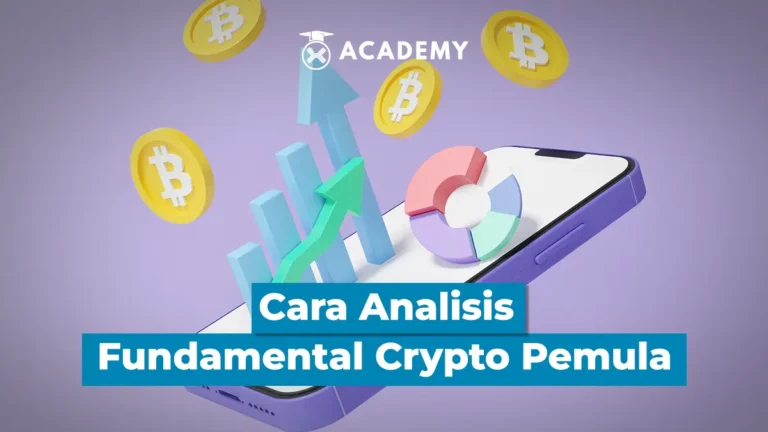Investing in crypto can feel like entering a wilderness without a map. This volatile and speculative market can be overwhelming, especially if you don’t know where to start. This is where fundamental crypto analysis becomes very important.
By understanding the basic factors that affect the value of a crypto asset, we can make wiser investment decisions. In this article, we will discuss why crypto fundamental analysis is important and how to do it easily, especially for beginners.
Let’s explore together aspects such as technology, development team, roadmap, and other factors that determine the value of a crypto asset.
What is Crypto Fundamental Analysis?
Crypto fundamental analysis, as conducted by experts, involves assessing aspects that affect the value of crypto assets, such as supply and demand, technology, and policy.
You should know that crypto fundamental analysis is the process of evaluating the underlying factors that affect the intrinsic value of a crypto asset. The goal is to determine whether a crypto is worth investing in and estimate its potential future value.
Unlike stock fundamental analysis, which focuses on a company’s financial performance, crypto fundamental analysis emphasizes factors such as the underlying technology of a crypto project, the development team, roadmap, community, and adoption prospects.
Why is Fundamental Analysis Important in the Crypto World?

As we already know, crypto markets are highly speculative and volatile, so fundamental analysis is very important to understand the intrinsic value behind a crypto asset. Fundamental analysis allows investors to make more informed investment decisions and reduce risk.
Fundamental analysis certainly helps investors avoid investing in crypto projects with weak fundamentals, such as fragile technology, incompetent development teams, or low adoption prospects.
How to Analyze Crypto Fundamentals for Beginners
Conducting a comprehensive fundamental analysis is important before investing in crypto assets. This way, you can understand the project’s long-term prospects and assess the investment’s potential gains or losses.
So, here below is how to analyze crypto fundamentals for beginners by knowing the key elements you should consider in crypto fundamental analysis. What are they? Let’s discuss it thoroughly.
-
Market Opportunity Analysis
The first step in fundamental crypto analysis for beginners is to understand whether the project meets a real market need and has a large target audience. Evaluating market needs and identifying potential user segments are essential for assessing the project’s future growth prospects.
-
Token Economic Analysis
Crypto assets typically use tokens as part of their ecosystem. Understanding the role and distribution of tokens in such projects is important. How tokens are distributed, whether there is a token burning mechanism, and how tokenomics is organized can affect the value and utility of the token itself.
-
Developer Team Analysis
A successful crypto project depends on a solid and experienced development team. Evaluate the core team members’ background, expertise, and previous achievements. A credible team with a good track record in the crypto industry or related technologies is more convincing.
-
Whitepaper Analysis
You need to know that a whitepaper is an important document that explains the project’s vision, technology, and roadmap. By carefully reviewing the whitepaper, you can understand the project’s goals, the feasibility of the technology used, and whether the project can be realized realistically.
-
Roadmap Analysis
As explained above, the project roadmap provides an overview of the development plan and long-term achievements. Evaluate the roadmap to ensure the project has a clear direction and realistic targets.
-
Technology Analysis
Blockchain technology and crypto is constantly evolving. It is important to assess whether the technology used by the project is scalable, interoperates with other systems, and uses an efficient consensus mechanism. Technologies that are innovative and adaptable to industry developments will be more profitable in the long run.
-
Partnership Analysis
Strategic partnerships with other companies or organizations can significantly benefit the project. Identify the project’s key partnerships and how they can support future growth and adoption.
-
Community Analysis
An active and enthusiastic community is crucial to the success of a crypto project. Evaluate the community’s engagement, sentiment, and support provided. A strong community can help promote the project, provide feedback, and encourage wider adoption.
-
User Adoption and Growth Analysis
Adoption rate and user base growth are important indicators for assessing a project’s popularity and potential. Monitor the number of active users and the growth rate of new users to understand the project’s traction.
-
Competition Analysis
No crypto project operates in a vacuum. It is important to compare the project with key competitors in the same market. Evaluate the competitive advantages, unique value proposition, and how the project can compete effectively.
-
Financial Analysis
While crypto projects are not always profit-oriented, it is important to understand revenue streams, funding sources, and spending transparency. Evaluate the revenue model and how the project will finance ongoing development.
-
Security Analysis
Security is a crucial aspect of the crypto industry. Evaluate a project’s resilience to security threats such as hacking, DDoS attacks, or other exploitation of weaknesses. Projects that prioritize security will be more attractive to investors.
-
Compliance with Regulations Analysis
The last way to analyze crypto fundamentals is to pay attention as crypto regulations evolve in many jurisdictions. Ensure the project you are considering complies with the relevant rules and regulations. Compliance can affect the legality of future operations and adoption. You can make smarter investment decisions and reduce risk by conducting a thorough fundamental analysis. Remember always to do your research and rely on trusted sources when evaluating crypto projects.
How to Distinguish a Genuine Vs Illegal Crypto Project?

To prevent scams about crypto projects, here are some characteristics that distinguish between legitimate and illegitimate crypto projects.
1. Developer Team
- Genuine projects usually have a credible team of developers with relevant backgrounds and experience in crypto or blockchain technology.
- Team members are publicly disclosed and information about them is publicly available.
- Non-genuine projects often hide the team’s identity anonymously or use fake identities.
2. Whitepaper
- Genuine crypto projects have whitepapers that explain the vision, technology, and roadmap in detail and make sense.
- The whitepaper is well written, uses appropriate technical terminology, and is plagiarism-free.
- Illegal projects may not have a whitepaper or look jumbled or copied from other sources.
3. Source Code
- Genuine projects usually have publicly accessible source code and have been independently audited to ensure security and compliance with the whitepaper.
- Non-genuine projects may not release source code or use code cobbled together from other sources.
4. Community and Activity
- The original project has an active community with consistent discussions, development activities, and engagement.
- There is real activity, such as updates, releases, and contributions from community members.
- Non-genuine projects often have inactive communities or activities that look fake or fabricated.
5. Transparency and Openness
- Genuine projects are usually transparent about their roadmap, updates, and use of funds raised from token sales.
- They engage in regular communication with the community and answer questions honestly.
- Non-genuine projects often lack transparency, provide vague information, or hide important details.
6. Regulatory Compliance
- Native projects strive to comply with the rules and regulations applicable in the jurisdictions in which they operate.
- They comply with anti-money laundering (AML) and know-your-customer verification (KYC).
- Non-genuine projects often ignore regulatory compliance or operate in legal gray areas.
7. Adoption and Real Use
- Original projects usually have real adoption and usage by users or business partners.
- There is evidence of integration and use of the platform/product by third parties.
- Non-genuine projects may claim exaggerated adoption or have no real users/partners.
To avoid scams or illegal schemes, it is important to conduct in-depth research, rely on trusted sources, and stay up-to-date in evaluating crypto projects.
Conclusion
Crypto fundamental analysis is an important process to understand a crypto asset’s intrinsic value and long-term prospects. Investors can make more informed investment decisions and reduce risk by conducting an in-depth analysis of factors such as technology, development team, roadmap, community, and adoption prospects.
While fundamental analysis does not guarantee investment success, it does provide investors with a better understanding of a crypto project’s strengths and weaknesses. As such, investors can avoid investing in projects with weak fundamentals and the potential to fail in the future.
However, it is important to remember that the crypto market is highly volatile and speculative. Despite conducting in-depth fundamental analysis, investors should remain aware of investment risks and only invest in amounts they can afford to lose. Always research, and don’t invest more than you can afford to lose.
By combining strong fundamental analysis with prudent risk management, you can increase their chances of success in investing in this volatile crypto market.
Remember that crypto investing requires patience, careful research, and a deep understanding of the fundamental factors underlying each crypto asset.
Therefore, it is important to do in-depth research, participate in education, such as reading updated information from the Crypto Academy, and familiarize yourself with the crypto assets you plan to invest in. The more knowledge you have, the wiser your investment decisions will be.
So, what are you waiting for? let’s invest in crypto assets from now on INDODAX while joining the Crypto Academy by reading the latest articles from INDODAX Academy to increase our understanding and skills in the crypto world & hopefully, the above article is useful.
FAQ
- What is Crypto Fundamental Analysis?
Crypto fundamental analysis is the process of evaluating the underlying factors that affect the intrinsic value of a crypto asset, such as its technology, development team, roadmap, and adoption prospects.
- Why is Crypto Fundamental Analysis Important?
Crypto fundamental analysis is important to understanding the intrinsic value behind a crypto asset. It allows investors to make more informed investment decisions and reduce risk.
- What Aspects to Consider in Crypto Fundamental Analysis?
Important aspects include market opportunity, token economics, development team, whitepaper, roadmap, technology, partnerships, community, user adoption and growth, competition, finance, security, and regulatory compliance.
- How to Distinguish between Genuine and Illegal Crypto Projects?
Genuine crypto projects have credible development teams, solid whitepapers, open-source code, active communities, transparency, regulatory compliance, and real adoption and usage. Illegal projects often show the opposite indications.





 Polkadot 8.91%
Polkadot 8.91%
 BNB 0.53%
BNB 0.53%
 Solana 4.86%
Solana 4.86%
 Ethereum 2.37%
Ethereum 2.37%
 Cardano 1.18%
Cardano 1.18%
 Polygon Ecosystem Token 2.14%
Polygon Ecosystem Token 2.14%
 Tron 2.85%
Tron 2.85%
 Market
Market


